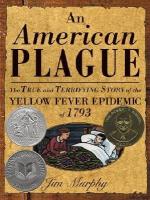
|
| Name: _________________________ | Period: ___________________ |
This test consists of 15 multiple choice questions and 5 short answer questions.
Multiple Choice Questions
1. What state refused to allow a ship from Philadelphia to land and take on water?
(a) New Jersey.
(b) New York.
(c) Massachusetts.
(d) Delaware.
2. After Dr. Rush's assistants bled him and administered the purge, how many days did it take for him to get back on his feet?
(a) 7.
(b) 6.
(c) 4.
(d) 5.
3. How many pounds of blood did Dr. Rush and other doctors at that time believe that the human body held?
(a) 15.
(b) 25.
(c) 10.
(d) 5.
4. What ship was seized by one of Genet's hired privateers?
(a) Alpha.
(b) Boyne.
(c) Roehampton.
(d) Adventure.
5. By September 17, how many burials were taking place daily?
(a) 75.
(b) 80.
(c) 85.
(d) 70.
6. How many whale oil streetlamps were in Philadelphia in 1793?
(a) 514.
(b) 662.
(c) 370.
(d) 434.
7. At the beginning of Chapter 6, about how many persons were ill with the fever?
(a) 7,000.
(b) 6,000.
(c) 8,000.
(d) 5,000.
8. What newspaper was printed occasionally by September?
(a) Philadelphia Daily Advertiser.
(b) National Gazette.
(c) Federal Gazette.
(d) Philadelphia Chronicle.
9. After Dr. Rush seemed to be cured of yellow fever, how many patients sought him in a day?
(a) 200.
(b) 100.
(c) 75.
(d) 150.
10. By the time Dr. Rush contracted yellow fever, how many doctors had died?
(a) 5.
(b) 10.
(c) 7.
(d) 12.
11. How many bundles of shirts and dresses for orphans were sent by the Widow Grubb?
(a) 12.
(b) 14.
(c) 16.
(d) 18.
12. How old was Stephen Girard in 1793?
(a) 64.
(b) 43.
(c) 36.
(d) 56.
13. By September 5, how many of Dr. Rush's patients did he claim improved with the Ten-and-Ten treatment?
(a) 15 out of 20.
(b) 29 out of 30.
(c) 8 out of 10.
(d) 3 out of 5.
14. When was someone hired to design and construct Philadelphia's first waterworks?
(a) 1795.
(b) 1799.
(c) 1812.
(d) 1801.
15. How many patients did Dr. Rush's five assistants each see in one day after Dr. Rush's recovery?
(a) 25.
(b) 30.
(c) 35.
(d) 40.
Short Answer Questions
1. How long was Dr. Currie's book about Philadelphia's plague?
2. When did Stephen Girard contract a mild case of yellow fever?
3. How often had the College of Physicians promised to meet during the plague?
4. How many high-ranking officials of the federal government were within a day's ride of Philadelphia?
5. When did the Black Plague strike in England?
|
This section contains 305 words (approx. 2 pages at 300 words per page) |

|




